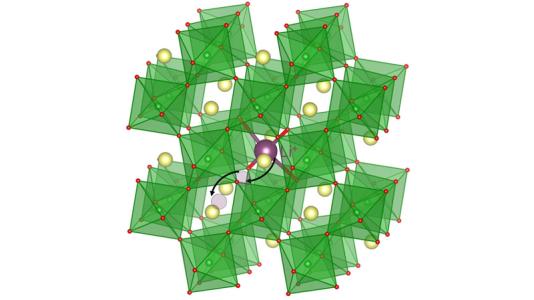
Scientific achievement
A solid state Li ion shuttle was created with rapid diffusion and reduced activation barriers by incorporating Li ions into a common crystal structure (SNO, SmNiO3 perovskite) under voltage bias.
Significance and impact
Solid state Li ion conductors based on the perovskite structure were created for potential use in energy conversion and information processing applications.
Research details
- Synchrotron XRR and XRD measurements were performed at the Advanced Photon Source.
- The high-performance computing Carbon cluster at the Center for Nanoscale Materials hosted first-principles DFT calculations and production simulations runs were run at the Argonne Leadership Computing Facility.
DOI: https://doi.org/10.1073/pnas.1805029115
Work was performed in part at the Center for Nanoscale Materials, Advanced Photon Source and Argonne Leadership Computing Facility.
About Argonne’s Center for Nanoscale Materials
The Center for Nanoscale Materials is one of the five DOE Nanoscale Science Research Centers, premier national user facilities for interdisciplinary research at the nanoscale supported by the DOE Office of Science. Together the NSRCs comprise a suite of complementary facilities that provide researchers with state-of-the-art capabilities to fabricate, process, characterize and model nanoscale materials, and constitute the largest infrastructure investment of the National Nanotechnology Initiative. The NSRCs are located at DOE’s Argonne, Brookhaven, Lawrence Berkeley, Oak Ridge, Sandia and Los Alamos National Laboratories. For more information about the DOE NSRCs, please visit https://science.osti.gov/User-Facilities/User-Facilities-at-a-Glance.
Argonne National Laboratory seeks solutions to pressing national problems in science and technology. The nation’s first national laboratory, Argonne conducts leading-edge basic and applied scientific research in virtually every scientific discipline. Argonne researchers work closely with researchers from hundreds of companies, universities, and federal, state and municipal agencies to help them solve their specific problems, advance America’s scientific leadership and prepare the nation for a better future. With employees from more than 60 nations, Argonne is managed by UChicago Argonne, LLC for the U.S. Department of Energy’s Office of Science.
The U.S. Department of Energy’s Office of Science is the single largest supporter of basic research in the physical sciences in the United States and is working to address some of the most pressing challenges of our time. For more information, visit https://energy.gov/science.